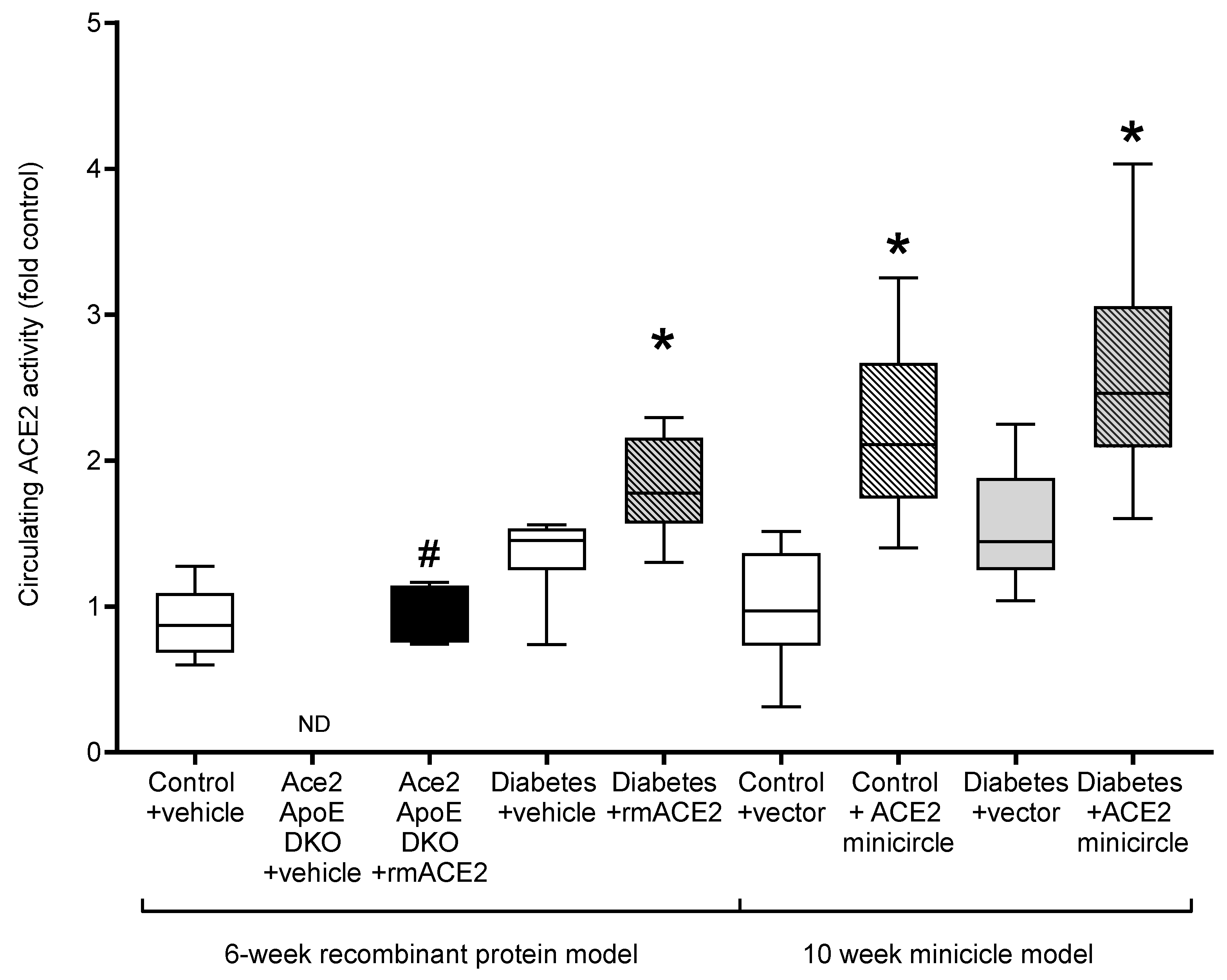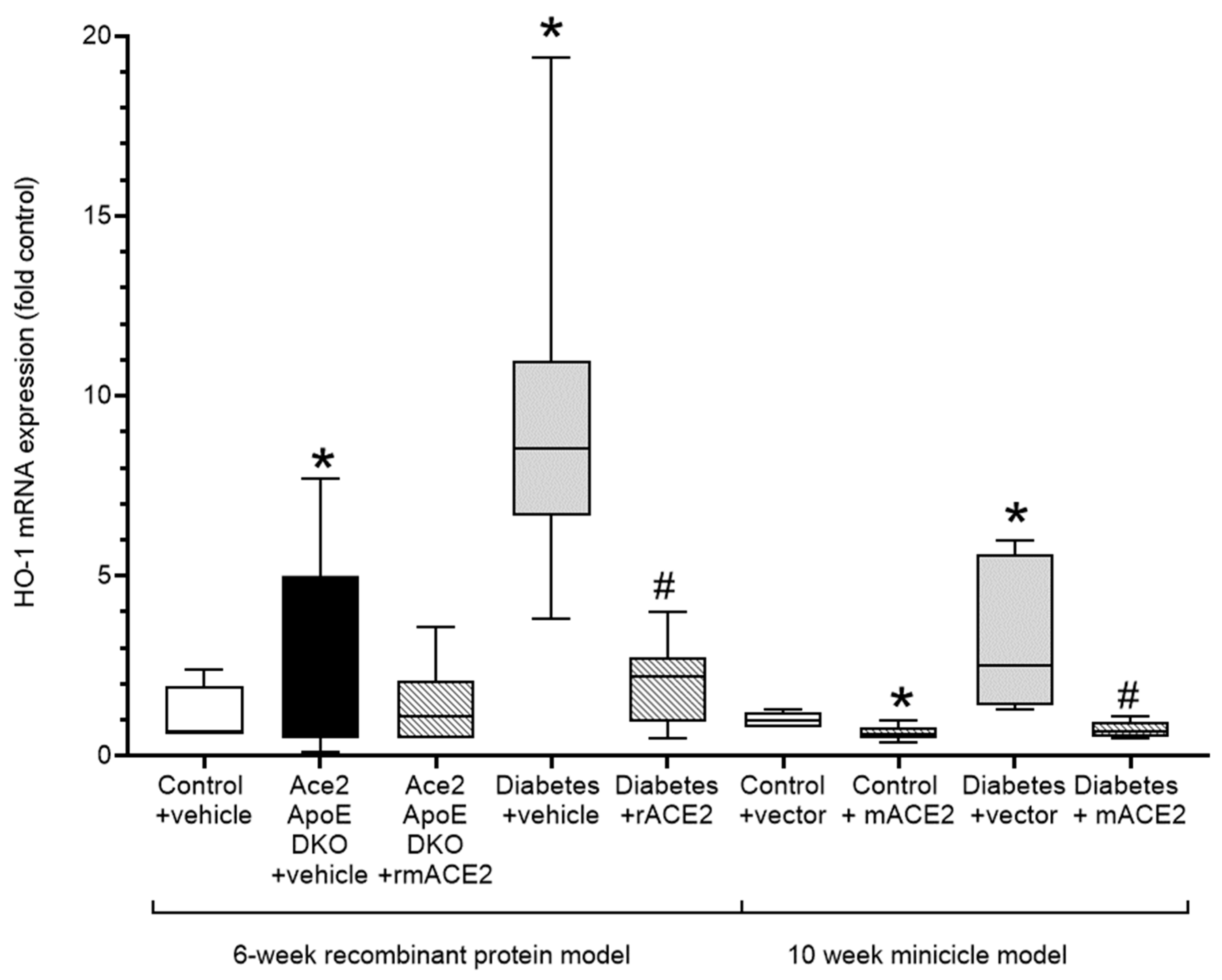Circulating Soluble ACE2 Plays an Independent Role to Protect against Vascular Damage in Diabetic Mice
Abstract
:1. Introduction
2. Materials and Methods
3. Results
3.1. Recombinant ACE2 Attenuates Atherosclerosis in ACE2/ApoE Double Knockout Mice
3.2. Recombinant ACE2 Attenuates Atherosclerosis in Diabetic ApoE Knockout Mice
3.3. DNA Minicircles Encoding Soluble ACE2 Attenuates Atherosclerosis in Diabetic ApoE Knockout Mice
3.4. Recombinant ACE2 and DNA Minicircles Encoding Soluble ACE2 Attenuate Oxidative Stress and Inflammation in the Vascular Wall in Diabetic ApoE Knockout Mice
4. Discussion
5. Conclusions
Author Contributions
Funding
Institutional Review Board Statement
Informed Consent Statement
Data Availability Statement
Acknowledgments
Conflicts of Interest
References
- Daugherty, A.; Manning, M.W.; Cassis, L.A. Angiotensin II promotes atherosclerotic lesions and aneurysms in apolipoprotein E–deficient mice. J. Clin. Investig. 2000, 105, 1605–1612. [Google Scholar] [CrossRef] [PubMed] [Green Version]
- Ferrario, C.M.; Strawn, W.B. Role of the Renin-Angiotensin-Aldosterone System and Proinflammatory Mediators in Cardiovascular Disease. Am. J. Cardiol. 2006, 98, 121–128. [Google Scholar] [CrossRef] [PubMed]
- Ekholm, M.; Kahan, T.; Jörneskog, G.; Bröijersen, A.; Wallén, N. Angiotensin II infusion in man is proinflammatory but has no short-term effects on thrombin generation in vivo. Thromb. Res. 2009, 124, 110–115. [Google Scholar] [CrossRef] [PubMed]
- Candido, R.; Jandeleit-Dahm, K.A.; Cao, Z.; Nesteroff, S.P.; Burns, W.C.; Twigg, S.M.; Dilley, R.J.; Cooper, M.E.; Allen, T.J. Prevention of Accelerated Atherosclerosis by Angiotensin-Converting Enzyme Inhibition in Diabetic Apolipoprotein E–Deficient Mice. Circulation 2002, 106, 246–253. [Google Scholar] [CrossRef] [Green Version]
- Candido, R.; Allen, T.J.; Lassila, M.; Cao, Z.; Thallas, V.; Cooper, M.E.; Jandeleit-Dahm, K.A. Irbesartan but Not Amlodipine Suppresses Diabetes-Associated Atherosclerosis. Circulation 2004, 109, 1536–1542. [Google Scholar] [CrossRef]
- Bernardi, S.; Zauli, G.; Tikellis, C.; Candido, R.; Fabris, B.; Secchiero, P.; Cooper, M.E.; Thomas, M. TNF-related apoptosis-inducing ligand significantly attenuates metabolic abnormalities in high-fat-fed mice reducing adiposity and systemic inflammation. Clin. Sci. 2012, 123, 547–555. [Google Scholar] [CrossRef]
- Rodrigues Prestes, T.R.; Rocha, N.P.; Miranda, A.S.; Teixeira, A.L.; Simoes-e-Silva, A.C. The Anti-Inflammatory Potential of ACE2/Angiotensin-(1-7)/Mas Receptor Axis: Evidence from Basic and Clinical Research. Curr. Drug Targets 2017, 18, 1301–1313. [Google Scholar] [CrossRef]
- Lambert, D.W.; Yarski, M.; Warner, F.J.; Thornhill, P.; Parkin, E.T.; Smith, A.I.; Turner, A.J. Tumor necrosis factor-alpha convertase (ADAM17) mediates regulated ectodomain shedding of the severe-acute respiratory syndrome-coronavirus (SARS-CoV) receptor, angiotensin-converting enzyme-2 (ACE2). J. Biol. Chem. 2005, 280, 30113–30119. [Google Scholar] [CrossRef] [Green Version]
- Federici, M.; Hribal, M.L.; Menghini, R.; Kanno, H.; Marchetti, V.; Porzio, O.; Sunnarborg, S.W.; Rizza, S.; Serino, M.; Cunsolo, V.; et al. Timp3 deficiency in insulin receptor-haploinsufficient mice promotes diabetes and vascular inflammation via increased TNF-. J. Clin. Investig. 2005, 115, 3494–3505. [Google Scholar] [CrossRef] [Green Version]
- Soro-Paavonen, A.; Gordin, D.; Forsblom, C.; Rosengard-Barlund, M.; Waden, J.; Thorn, L.; Sandholm, N.; Thomas, M.C.; Groop, P.-H. Circulating ACE2 activity is increased in patients with type 1 diabetes and vascular complications. J. Hypertens. 2012, 30, 375–383. [Google Scholar] [CrossRef]
- Xiao, F.; Zimpelmann, J.; Agaybi, S.; Gurley, S.B.; Puente, L.; Burns, K.D. Characterization of Angiotensin-Converting Enzyme 2 Ectodomain Shedding from Mouse Proximal Tubular Cells. PLoS ONE 2014, 9, e85958. [Google Scholar] [CrossRef] [PubMed]
- Hussain, A.; Tang, O.; Sun, C.; Jia, X.; Selvin, E.; Nambi, V.; Folsom, A.; Heiss, G.; Zannad, F.; Mosley, T.; et al. Soluble Angiotensin-Converting Enzyme 2, Cardiac Biomarkers, Structure, and Function, and Cardiovascular Events (from the Atherosclerosis Risk in Communities Study). Am. J. Cardiol. 2021, 146, 15–21. [Google Scholar] [CrossRef] [PubMed]
- Narula, S.; Yusuf, S.; Chong, M.; Ramasundarahettige, C.; Rangarajan, S.; Bangdiwala, S.I.; van Eikels, M.; Leineweber, K.; Wu, A.; Pigeyre, M.; et al. Plasma ACE2 and risk of death or cardiometabolic diseases: A case-cohort analysis. Lancet 2020, 396, 968–976. [Google Scholar] [CrossRef]
- Thomas, M.C.; Pickering, R.J.; Tsorotes, D.; Koitka, A.; Sheehy, K.; Bernardi, S.; Toffoli, B.; Nguyen-Huu, T.-P.; Head, G.A.; Fu, Y.; et al. Genetic Ace2 Deficiency Accentuates Vascular Inflammation and Atherosclerosis in the ApoE Knockout Mouse. Circ. Res. 2010, 107, 888–897. [Google Scholar] [CrossRef] [PubMed] [Green Version]
- Lee, M.A.; Böhm, M.; Paul, M.; Ganten, D. Tissue renin-angiotensin systems. Their role in cardiovascular disease. Circulation 1993, 87, IV7–IV13. [Google Scholar] [PubMed]
- Lewis, P.; Stefanovic, N.; Pete, J.; Calkin, A.; Giunti, S.; Thallas-Bonke, V.; Jandeleit-Dahm, K.A.; Allen, T.J.; Kola, I.; Cooper, M.E.; et al. Lack of the Antioxidant Enzyme Glutathione Peroxidase-1 Accelerates Atherosclerosis in Diabetic Apolipoprotein E–Deficient Mice. Circulation 2007, 115, 2178–2187. [Google Scholar] [CrossRef] [Green Version]
- Libby, P.; Ridker, P.M.; Maseri, A. Inflammation and atherosclerosis. Circulation 2002, 105, 1135–1143. [Google Scholar] [CrossRef]
- Crackower, M.A.; Sarao, R.; Oudit, G.Y.; Yagil, C.; Kozieradzki, I.; Scanga, S.E.; Oliveira-Dos-Santos, A.J.; Da Costa, J.; Zhang, L.; Pei, Y.; et al. Angiotensin-converting enzyme 2 is an essential regulator of heart function. Nature 2002, 417, 822–828. [Google Scholar] [CrossRef]
- Yamamoto, K.; Ohishi, M.; Katsuya, T.; Ito, N.; Ikushima, M.; Kaibe, M.; Tatara, Y.; Shiota, A.; Sugano, S.; Takeda, S.; et al. Deletion of Angiotensin-Converting Enzyme 2 Accelerates Pressure Overload-Induced Cardiac Dysfunction by Increasing Local Angiotensin II. Hypertension 2006, 47, 718–726. [Google Scholar] [CrossRef] [Green Version]
- Moran, C.S.; Biros, E.; Krishna, S.; Wang, Y.; Tikellis, C.; Morton, S.K.; Moxon, J.V.; Cooper, M.E.; Norman, P.E.; Burrell, L.M.; et al. Resveratrol Inhibits Growth of Experimental Abdominal Aortic Aneurysm Associated With Upregulation of Angiotensin-Converting Enzyme 2. Arter. Thromb. Vasc. Biol. 2017, 37, 2195–2203. [Google Scholar] [CrossRef] [Green Version]
- Patel, V.; Takawale, A.; Ramprasath, T.; Das, S.K.; Basu, R.; Grant, M.B.; Hall, D.; Kassiri, Z.; Oudit, G.Y. Antagonism of angiotensin 1–7 prevents the therapeutic effects of recombinant human ACE2. Klin. Wochenschr. 2015, 93, 1003–1013. [Google Scholar] [CrossRef] [PubMed] [Green Version]
- Lo, J.; Patel, V.B.; Wang, Z.; Levasseur, J.; Kaufman, S.; Penninger, J.M.; Oudit, G.Y. Angiotensin-converting enzyme 2 antagonizes angiotensin II-induced pressor response and NADPH oxidase activation in Wistar-Kyoto rats and spontaneously hypertensive rats. Exp. Physiol. 2012, 98, 109–122. [Google Scholar] [CrossRef]
- Ferrario, C.M.; Trask, A.J.; Jessup, J.A. Advances in biochemical and functional roles of angiotensin-converting enzyme 2 and angiotensin-(1–7) in regulation of cardiovascular function. Am. J. Physiol. Circ. Physiol. 2005, 289, H2281–H2290. [Google Scholar] [CrossRef] [PubMed] [Green Version]
- Johnson, J.A.; Hemnes, A.R.; Perrien, D.S.; Schuster, M.; Robinson, L.J.; Gladson, S.; Loibner, H.; Bai, S.; Blackwell, T.R.; Tada, Y.; et al. Cytoskeletal defects in Bmpr2-associated pulmonary arterial hypertension. Am. J. Physiol. Cell. Mol. Physiol. 2012, 302, L474–L484. [Google Scholar] [CrossRef] [PubMed] [Green Version]
- Wysocki, J.; Ye, M.; Khattab, A.M.; Fogo, A.; Martin, A.; David, N.V.; Kanwar, Y.; Osborn, M.; Batlle, D. Angiotensin-converting enzyme 2 amplification limited to the circulation does not protect mice from development of diabetic nephropathy. Kidney Int. 2016, 91, 1336–1346. [Google Scholar] [CrossRef]
- Qi, Z.; Fujita, H.; Jin, J.; Davis, L.S.; Wang, Y.; Fogo, A.B.; Breyer, M.D. Characterization of Susceptibility of Inbred Mouse Strains to Diabetic Nephropathy. Diabetes 2005, 54, 2628–2637. [Google Scholar] [CrossRef] [Green Version]



| Body Weight (g) | Blood Glucose (mmol/L) | HbA1c (%) | Systolic Blood Pressure (mmHg) | |
|---|---|---|---|---|
| 6-week model | ||||
| ApoE KO | 28 ± 0.5 | 10.9 ± 0.5 | 4.4 ± 0.1 | 104 ± 2 |
| ApoE/Ace2 DKO | 26.2 ± 0.4 | 11.2 ± 0.4 | 4.5 ± 0.1 | 107 ± 1 * |
| ApoE/Ace2 DKO + rmACE2 | 26 ± 0.5 | 11 ± 0.3 | 4.7 ± 0.3 | 106 ± 2 |
| ApoE KO + Diabetes | 21 ± 1.0 * | 25 ± 2.5 * | 9.2 ± 0.2 * | 108 ± 2 * |
| ApoE KO + Diabetes + rmACE2 | 22 ± 2.0 * | 28 ± 0.5 * | 8.7 ± 0.9 * | 107 ± 1 * |
| 10-week model | ||||
| ApoE KO | 29 ± 0.9 | 12 ± 0.9 | 4.8 ± 0.2 | 106 ± 1 |
| ApoE KO + ACE2 minicircle | 30 ± 1.0 | 10 ± 1.0 | 4.1 ± 0.1 | 106 ± 1 |
| ApoE KO + Diabetes | 24 ± 0.8 * | 30 ± 1.5 * | 12.3 ± 0.6 * | 108 ± 1 |
| ApoE KO + Diabetes + ACE2 minicircle | 27 ± 0.8 # | 25 ± 3.0 * | 10.0 ± 0.4 * | 103 ± 4 |
| IL-6 | TNFα | VCAM-1 | MCP1 | KLF3 | CD11b | |
|---|---|---|---|---|---|---|
| ApoE KO | 1.0 ± 0.2 | 1.0 ± 0.2 | 1.0 ± 0.1 | 1.0 ± 0.2 | 1.0 ± 0.2 | 1.1 ± 0.3 |
| ApoE/Ace2 DKO | 5.5 ± 1.9 * | 1.4 ± 0.6 | 0.5 ± 0.2 | 4.4 ± 1.5 * | 1.3 ± 0.8 | 1.8 ± 0.5 |
| ApoE/Ace2 DKO + rmACE2 | 0.5 ± 0.1 | 2.7 ± 0.9 | 0.7 ± 0.4 | 0.9 ± 0.2 | 1.5 ± 0.6 | 0.8 ± 0.2 |
| ApoE KO + Diabetes | 6.4 ± 2.2 * | 3.6 ± 0.8 * | 4.0 ± 1.0 * | 3.7 ± 0.9 * | 2.9 ± 0.7 | 3.9 ± 0.9 * |
| ApoE KO + Diabetes + rmACE2 | 0.5 ± 0.2 *# | 1.4 ± 0.5 # | 0.4 ± 0.1 # | 1.2 ± 0.2 # | 1.7 ± 0.4 | 2.3 ± 0.4 |
| 10-week model | ||||||
| ApoE KO | 1.0 ± 0.2 | 1.0 ± 0.2 | 1.0 ± 0.2 | 1.0 ± 0.2 | 1.0 ± 0.1 | 1.1 ± 0.1 |
| ApoE KO + ACE2 minicircle | 0.3 ± 0.1 * | 0.2 ± 0.1 | 0.7 ± 0.1 | 0.1 ± 0.01 * | 1.6 ± 0.2 | 1.1 ± 0.2 |
| ApoE KO + Diabetes | 1.9 ± 0.4 * | 3.5 ± 1.2 * | 3.7 ± 1.1 * | 3.1 ± 0.8 * | 2.7 ± 0.7 * | 2.7 ± 0.6 * |
| ApoE KO + Diabetes + ACE2 minicircle | 0.6 ± 0.1 # | 0.8 ± 0.3 # | 0.8 ± 0.1 # | 0.3 ± 0.06 # | 1.6 ± 0.2 | 1.4 ± 0.1 |
Publisher’s Note: MDPI stays neutral with regard to jurisdictional claims in published maps and institutional affiliations. |
© 2022 by the authors. Licensee MDPI, Basel, Switzerland. This article is an open access article distributed under the terms and conditions of the Creative Commons Attribution (CC BY) license (https://creativecommons.org/licenses/by/4.0/).
Share and Cite
Tikellis, C.; Robinson, G.N.; Rosado, C.J.; Batu, D.; Zuniga-Gutierrez, M.A.; Pickering, R.J.; Thomas, M.C. Circulating Soluble ACE2 Plays an Independent Role to Protect against Vascular Damage in Diabetic Mice. Antioxidants 2022, 11, 987. https://doi.org/10.3390/antiox11050987
Tikellis C, Robinson GN, Rosado CJ, Batu D, Zuniga-Gutierrez MA, Pickering RJ, Thomas MC. Circulating Soluble ACE2 Plays an Independent Role to Protect against Vascular Damage in Diabetic Mice. Antioxidants. 2022; 11(5):987. https://doi.org/10.3390/antiox11050987
Chicago/Turabian StyleTikellis, Chris, Gardner N. Robinson, Carlos J. Rosado, Duygu Batu, Maria A. Zuniga-Gutierrez, Raelene J. Pickering, and Merlin C. Thomas. 2022. "Circulating Soluble ACE2 Plays an Independent Role to Protect against Vascular Damage in Diabetic Mice" Antioxidants 11, no. 5: 987. https://doi.org/10.3390/antiox11050987
APA StyleTikellis, C., Robinson, G. N., Rosado, C. J., Batu, D., Zuniga-Gutierrez, M. A., Pickering, R. J., & Thomas, M. C. (2022). Circulating Soluble ACE2 Plays an Independent Role to Protect against Vascular Damage in Diabetic Mice. Antioxidants, 11(5), 987. https://doi.org/10.3390/antiox11050987






